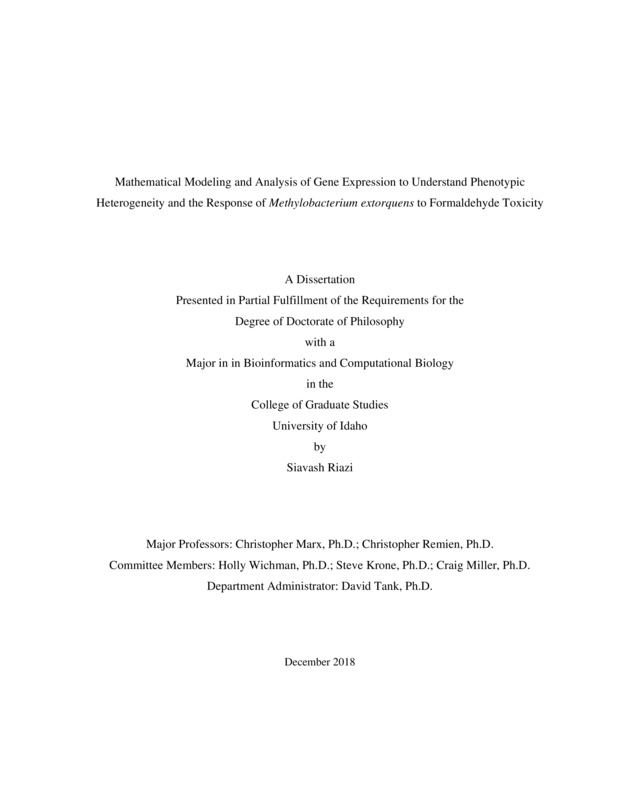Mathematical Modeling and Analysis of Gene Expression to Understand Phenotypic Heterogeneity and the Response of Methylobacterium extorquens to Formaldehyde Toxicity
Riazi, Siavash. (2018-12). Mathematical Modeling and Analysis of Gene Expression to Understand Phenotypic Heterogeneity and the Response of Methylobacterium extorquens to Formaldehyde Toxicity. Theses and Dissertations Collection, University of Idaho Library Digital Collections. https://www.lib.uidaho.edu/digital/etd/items/riazi_idaho_0089e_11468.html
- Title:
- Mathematical Modeling and Analysis of Gene Expression to Understand Phenotypic Heterogeneity and the Response of Methylobacterium extorquens to Formaldehyde Toxicity
- Author:
- Riazi, Siavash
- Date:
- 2018-12
- Embargo Remove Date:
- 2021-07-08
- Keywords:
- Bacterial physiology Dynamic systems Gene expression analysis Mathematical modeling RNA-seq analysis Stress response
- Program:
- Bioinformatics & Computational Biology
- Subject Category:
- Bioinformatics; Microbiology; Biology
- Abstract:
-
Methylobacterium extorquens is a facultative methylotrophic bacterium that lives on plant leaves. As part of the natural oxidation pathway of methanol secreted from the leaves, formaldehyde is generated. Experiments have shown there is phenotypic heterogeneity in tolerance to formaldehyde, and this heterogeneity varies continuously. Exposing M. extorquens to a high concentration (4 mM) of formaldehyde changed the distribution of tolerance to formaldehyde. In the second chapter of this dissertation, I introduced a mathematical model to investigate the processes involved in the change of the tolerance distribution. The model suggests there is an absolute threshold between survival and death in face of the stress from formaldehyde. In addition, I showed growth and death are not sufficient to explain the change of distribution of tolerance, and in fact, there is also a suggestion for phenotypic movements that permit the cells to change their phenotypic states. Moreover, the model showed that the phenotypic movements that occur depend upon the environmental conditions. In the third chapter, I investigated the genes involved in response to formaldehyde stress using RNA-seq analysis. In order to find specific mechanisms involved in formaldehyde-mediated translation inhibition, cultures of bacteria treated with either formaldehyde and kanamycin was investigated. To assess the role of the EfgA protein – which has a role in translation inhibition by formaldehyde – WT and ΔefgA strains were investigated in the mentioned treatments. I showed that a great portion of the response to formaldehyde is shared with the kanamycin response, and that having EfgA protein is crucial to the formaldehyde stress response. Analysis of functional gene groups showed that cytochromes, chaperones, DNA damage repair system, ABC transporters and flagellar proteins are among the highly affected genes in response to the formaldehyde. This analysis of RNA-seq data provides a set of candidate genes that potentially have role in the phenotypic heterogeneity in tolerance to formaldehyde.
- Description:
- doctoral, Ph.D., Bioinformatics & Computational Biology -- University of Idaho - College of Graduate Studies, 2018-12
- Major Professor:
- Marx, Christopher J.; Remien, Christopher H.
- Committee:
- Wichman, Holly; Krone, Steve; Miller, Craig
- Defense Date:
- 2018-12
- Identifier:
- Riazi_idaho_0089E_11468
- Type:
- Text
- Format Original:
- Format:
- application/pdf
- Rights:
- In Copyright - Educational Use Permitted. For more information, please contact University of Idaho Library Special Collections and Archives Department at libspec@uidaho.edu.
- Standardized Rights:
- http://rightsstatements.org/vocab/InC-EDU/1.0/

